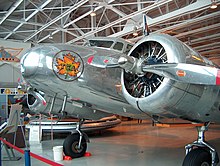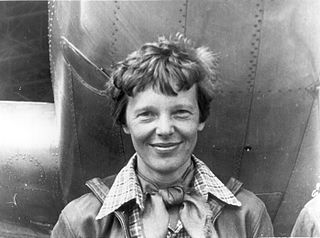
Amelia Mary Earhart was an American aviation pioneer and writer. Earhart was the first female aviator to fly solo across the Atlantic Ocean. She set many other records, was one of the first aviators to promote commercial air travel, wrote best-selling books about her flying experiences, and was instrumental in the formation of The Ninety-Nines, an organization for female pilots.
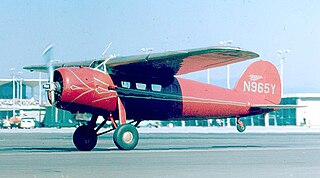
The Lockheed Vega is an American five- to seven-seat high-wing monoplane airliner built by the Lockheed Corporation starting in 1927. It became famous for its use by a number of record-breaking pilots who were attracted to its high speed and long range. Amelia Earhart became the first woman to fly solo across the Atlantic Ocean in one, and Wiley Post used his to prove the existence of the jet stream after flying around the world twice.

The Fokker F27 Friendship is a turboprop airliner developed and manufactured by the Dutch aircraft manufacturer Fokker. It is the most numerous post-war aircraft manufactured in the Netherlands; the F27 was also one of the most successful European airliners of its era.
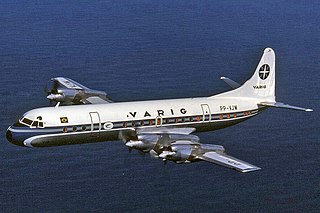
The Lockheed L-188 Electra is an American turboprop airliner built by Lockheed. First flown in 1957, it was the first large turboprop airliner built in the United States. Initial sales were good, but after two fatal crashes that led to expensive modifications to fix a design defect, no more were ordered. With its fairly high power-to-weight ratio, huge propellers and very short wings, large Fowler flaps which significantly increased effective wing area when extended, and four-engined design, the airplane had airfield performance capabilities unmatched by many jet transport aircraft even today—particularly on short runways and high field elevations. Jet airliners soon supplanted turboprops for many purposes, and many Electras were modified as freighters. Some Electras are still being used in various roles into the 21st century. The airframe was also used as the basis for the Lockheed P-3 Orion maritime patrol aircraft.
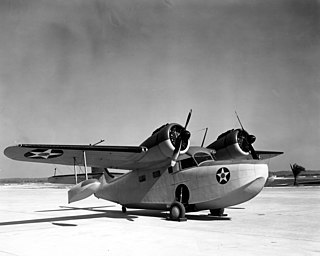
The Grumman G-21 Goose is an amphibious flying boat designed by Grumman to serve as an eight-seat "commuter" aircraft for businessmen in the Long Island area. The Goose was Grumman's first monoplane to fly, its first twin-engined aircraft, and its first aircraft to enter commercial airline service. During World War II, the Goose became an effective transport for the US military, as well as serving with many other air forces. During hostilities, the Goose took on an increasing number of combat and training roles.

The Lockheed Hudson is a light bomber and coastal reconnaissance aircraft built by the American Lockheed Aircraft Corporation. It was initially put into service by the Royal Air Force shortly before the outbreak of the Second World War and primarily operated by it thereafter. The Hudson was a military conversion of the Model 14 Super Electra airliner, and was the first significant aircraft construction contract for Lockheed — the initial RAF order for 200 Hudsons far surpassed any previous order the company had received.

The Lockheed Model 18 Lodestar is a passenger transport aircraft of the World War II era.

The Lockheed JetStar is a business jet produced from the early 1960s to the 1970s. The JetStar was the first dedicated business jet to enter service, as well as the only such airplane built by Lockheed. It was also one of the largest aircraft in the class for many years, seating ten plus two crew. It is distinguishable from other small jets by its four engines, mounted on the rear of the fuselage, and the "slipper"-style fuel tanks fixed to the wings.

The Lockheed Model 14 Super Electra was an American civil passenger and cargo aircraft built by the Lockheed Aircraft Corporation during the late 1930s. An outgrowth of the earlier Model 10 Electra, the Model 14 was also developed into larger, more capable civil and military versions.

The Lockheed Model 12 Electra Junior, more commonly known as the Lockheed 12 or L-12, is an eight-seat, six-passenger all-metal twin-engine transport aircraft of the late 1930s designed for use by small airlines, companies, and wealthy private individuals. A smaller version of the Lockheed Model 10 Electra, the Lockheed 12 was not popular as an airliner but was widely used as a corporate and government transport. Several were also used for testing new aviation technologies.

Johan Adolf Pengel International Airport, also known as Paramaribo-Zanderij International Airport, and locally referred to simply as JAP, is an airport located in the town of Zanderij and hub for airline carrier Surinam Airways, 45 kilometres (28 mi) south of Paramaribo. It is the larger of Suriname's two international airports, the other being Zorg en Hoop with scheduled flights to Guyana, and is operated by Airport Management, Ltd./ NV Luchthavenbeheer.

The Lockheed R6V Constitution was a large, propeller-driven, double-decker transport aircraft developed in the 1940s by Lockheed as a long-range, high-capacity transport and airliner for the U.S. Navy and Pan American Airways. Only two of the aircraft were ever built, both prototypes. Although these two planes went into service with the Navy, the Constitution design ultimately proved underpowered and too large for practical airline use at the time. Although the Martin JRM Mars flying boat had a slightly longer wingspan, the Constitution remains the largest fixed-wing aircraft type ever operated by the U.S. Navy.

The Martin 4-0-4 was an American pressurized passenger airliner built by the Glenn L. Martin Company. In addition to airline use initially in the United States, it was used by the United States Coast Guard and United States Navy as the RM-1G.

The de Havilland DH.104 Dove is a British short-haul airliner developed and manufactured by de Havilland. The design, which was a monoplane successor to the pre-war Dragon Rapide biplane, came about from the Brabazon Committee report which, amongst other aircraft types, called for a British-designed short-haul feeder for airlines.
The Royal Aviation Museum of Western Canada is a museum in Winnipeg, Manitoba, Canada. The museum opened to the public in its new location on 21 May 2022.

The Avro Avian is a series of British light aircraft designed and built by Avro in the 1920s and 1930s. While the various versions of the Avian were sound aircraft, they were comprehensively outsold by the de Havilland Moth and its descendants.

Amelia is a 2009 biographical film about aviatrix Amelia Earhart. The film stars Hilary Swank as Earhart, and co-stars Richard Gere, Ewan McGregor, Christopher Eccleston and Joe Anderson. The film was directed by Mira Nair and based on The Sound of Wings by Mary S. Lovell. The film received predominantly negative reviews, with critics polarized over the performances and criticizing the film's story.

Ann Dearing Holtgren Pellegreno is a professional musician, teacher, author, lecturer, and farmer. In 1967, Pellegreno and a crew of three successfully flew a similar aircraft to complete a world flight that closely mirrored Amelia Earhart's flight plan in 1937. On the 30th anniversary of Earhart's disappearance, Pellegreno dropped a wreath in her honor over tiny Howland Island and returned to Oakland, California, completing the 28,000-mile (45,000 km) commemorative flight on July 7, 1967.

The Laister-Kauffmann TG-4 was a sailplane produced in the United States during the Second World War for training cargo glider pilots. It was a conventional sailplane design with a fuselage of steel tube construction and wooden wings and tail, covered all over with fabric. The pilot and instructor sat in tandem under a long canopy.

The Douglas DC-2 is a 14-passenger, twin-engined airliner that was produced by the American company Douglas Aircraft Company starting in 1934. It competed with the Boeing 247. In 1935, Douglas produced a larger version called the DC-3, which became one of the most successful aircraft in history.











